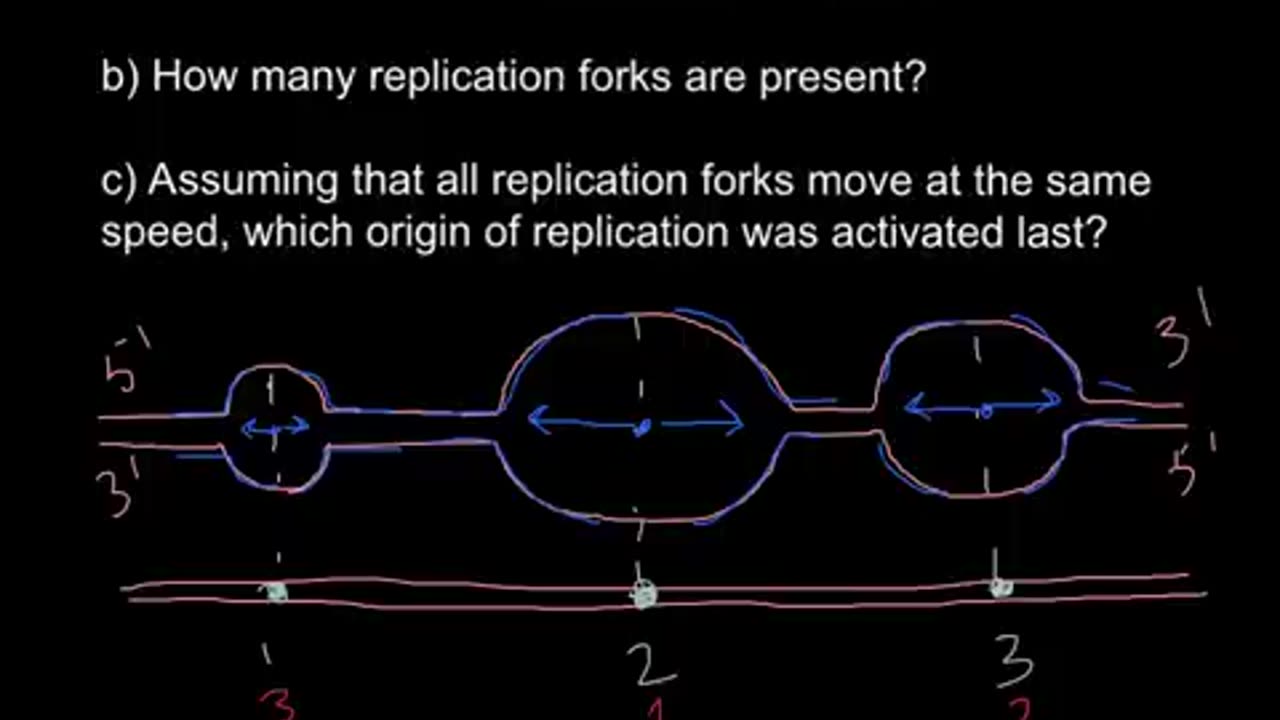Premium Only Content

DNA. Origin of replication
The origin of replication (also called the replication origin) is a particular sequence in a genome at which replication is initiated. This can either involve the replication of DNA in living organisms such as prokaryotes and eukaryotes, or that of DNA or RNA in viruses, such as double-stranded RNA viruses.
DNA replication may proceed from this point bidirectionally or unidirectionally.
The specific structure of the origin of replication varies somewhat from species to species, but all share some common characteristics such as high AT content. The origin of replication binds the pre-replication complex, a protein complex that recognizes, unwinds, and begins to copy DNA.
There are also significant differences between prokaryotic and eukaryotic origins of replication:
Bacteria have a single circular molecule of DNA, and typically only a single origin of replication per circular chromosome.
Archaea have a single circular molecule of DNA, and several origins of replication along this circular chromosome.
Eukaryotes often have multiple origins of replication on each linear chromosome that initiate at different times (replication timing), with up to 100,000 present in a single human cell. Having many origins of replication helps to speed the duplication of their (usually) much larger store of genetic material. The segment of DNA that is copied starting from each unique replication origin is called a replicon.
Origins of replication are typically assigned names containing ori.
Bacterial Genome Origins
The genome of E. coli is contained in a single circular DNA molecule of 4.6 x 106 nucleotide pairs. DNA replication begins at a single origin of replication. Replication origin is known as oriC. In E. coli, the oriC consists of three A-T rich 13-mer repeats and four 9-mer repeats. Ten to 20 monomers of the replication protein dnaA bind to the 9 mer repeats, and the DNA coils around this protein complex forming a protein core. This coiling stimulates the AT rich region in the 13 mer sequence to unwind, allowing copies of the helicase dnaB and its cofactor protein dnaC to bind to each strand of the resulting single-stranded DNA. The dnaB protein forms the basis of the replisome, a complex of enzymes that performs DNA replication.
Bacterial Plasmid Origins
Many bacteria, including E. coli, contain plasmids that each contain an origin of replication. These are separate from the origins of replication that are used by the bacteria to copy their genome and often function very differently. For example, the E. coli plasmid pBR322 uses a protein called Rop/Rom to regulate the number of plasmids that are within each bacterial cell. The most common origin of replication that is used in plasmids for genetic engineering is called pUC. This origin is derived from pBR322 but it contains two mutations. One single point mutation in the origin itself and another that deletes the Rop/Rom gene. This removes all the regulatory constraints on the plasmids replication and the bacteria then go from producing 30-40 plasmids per cell with pBR322 up to producing over 500 with pUC. This allows genetic engineers to produce large quantities of DNA for research purposes. Other origins of replication include pSC101 (derived from Salmonella, around 5 copies per cell), 15A origin (derived from p15A, 10-20 copies per cell) and Bacterial artificial chromosomes (1 copy per cell).
Eukaryotic
In eukaryotes, the budding yeast Saccharomyces cerevisiae has the best characterised replication origins. These origins were first identified by their ability to support the replication of mini-chromosomes or plasmids, giving rise to the name Autonomously replicating sequences or ARS elements. Each budding yeast origin consists of a short (~11 bp) essential DNA sequence (called the ARS consensus sequence or ACS) that recruits replication proteins.
In other eukaryotes, including humans, the DNA sequences at the replication origins vary. Despite this sequence variation, all the origins form a base for assembly of a group of proteins known collectively as the pre-replication complex (pre-RC):
First, the origin DNA is bound by the origin recognition complex (ORC) which, with help from two further protein factors (Cdc6 and Cdt1), load the mini chromosome maintenance (or MCM) protein complex.
-
 34:26
34:26
Misfits Mania
4 hours ago $7.97 earnedMISFITS MANIA: Launch Press Conference
71.7K14 -
 LIVE
LIVE
Dr Disrespect
4 hours ago🔴LIVE - DR DISRESPECT - WARZONE x BLACK OPS 7 - SEASON 1 INTEGRATION
1,445 watching -

DeVory Darkins
3 hours agoBOMBSHELL: Congress drops BRUTAL NEWS for Tim Walz after Comer announces Probe
145K38 -
 1:15:17
1:15:17
Sean Unpaved
3 hours agoPlayoff Implications On The Line For Cowboys vs. Lions NFC SHOWDOWN! | UNPAVED
22.4K -
 59:30
59:30
Simply Bitcoin
21 hours ago $0.31 earnedThe Bitcoin Crucible w/ Alex Stanczyk & Daniel Batten - Episode 11
10.2K3 -
 8:44
8:44
Jamesons Travels
17 hours ago $0.85 earnedCongress Created This Mess…Now Troops Pay the Price
8.55K15 -
 1:00:13
1:00:13
Timcast
3 hours agoTrump DUNKS On Somalis, Calls For Ilhan Omar To Be DEPORTED
150K46 -
 2:30:27
2:30:27
Steven Crowder
5 hours agoNick Fuentes Sits Down with Crowder
531K1.44K -
 1:07:12
1:07:12
The Rubin Report
4 hours agoHost Gets Visibly Angry as Scott Bessent Rips Him to Shreds in Front of NY Times Crowd
64.7K37 -
 4:42
4:42
Buddy Brown
5 hours ago $1.03 earnedThe Most GHETTO Chick-fil-A Customer EVER! | Buddy Brown
14.9K10